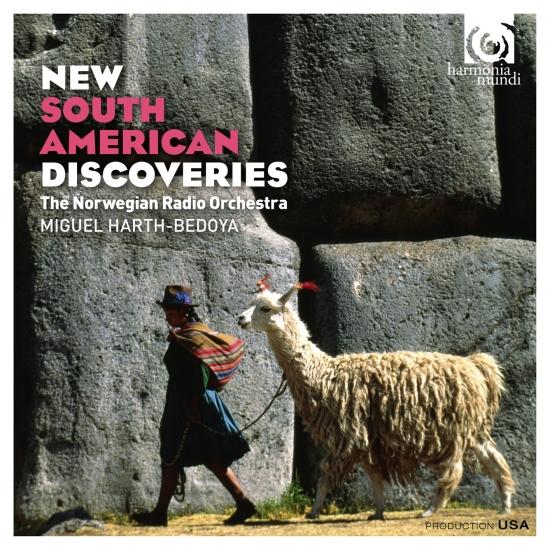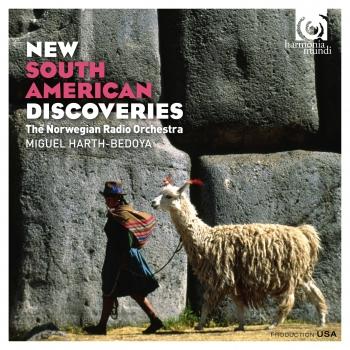
New South American Discoveries Miguel Harth-Bedoya and The Norwegian Radio Orchestra
Album info
Album-Release:
2016
HRA-Release:
21.11.2016
Label: harmonia mundi
Genre: Classical
Subgenre: Orchestral
Artist: Miguel Harth-Bedoya and The Norwegian Radio Orchestra
Album including Album cover
- Jorge Villavicencio Grossmann (1973):
- 1Wayra04:37
- Victor Agudelo (1979):
- 2El Sombrerón09:07
- Sebastián Vergara (1978):
- 3Mecánica07:22
- Diego Luzuriaga (1955):
- 4Responsorio08:44
- Diego Vega (1968):
- 5Música Muisca05:47
- Sebastián Errázuriz (1977):
- 6La Caravana09:04
- Agustín Fernández (1947-2016): Una Música Escondida:
- 7I. Preludio con vaticinios04:01
- 8II. Nana con despedida04:05
- 9III. Final con campanas05:52
- Antonio Gervasoni (1973):
- 10Icarus06:18
Info for New South American Discoveries
Grammy®-nominated and Emmy Award-winning conductor Miguel Harth-Bedoya leading the Norwegian Radio Orchestra introduces his fifth album for the prestigious international label, New South American Discoveries. In addition to his positions as music director with the Norwegian Radio Orchestra and the Fort Worth Symphony Orchestra, the Peruvian-born conductor is also Founder and Artistic Director of Caminos del Inka, Inc., a non-profit organization dedicated to performing and promoting the music of the Americas.
Harth-Bedoya’s first critically-acclaimed album for Harmonia Mundi highlighted the orchestral music of fellow-Peruvian, and acclaimed composer, Jimmy López. For his latest recording, the conductor celebrates music by eight living composers from five South American countries all born after 1950: Jorge Villavicencio Grossman (Peru); Victor Agudelo (Colombia); Sebastián Vergara (Chile); Diego Luzuriaga (Ecuador); Diego Vega (Colombia); Sebastián Errázuriz (Chile); Agustín Fernández (Bolivia), and Antonio Gervasoni (Peru).
“I like to think of this recording as a gateway to listening differently to South American music,” says conductor Miguel Harth-Bedoya. “In selecting these works, my underlying purpose was to bring forward a new generation of South American composers, and to illuminate the breadth and depth of their musical form and style. Each composer brings a different musical language to the project, some drawing on a connection to land or nation, others using a more abstract approach. What these composers have in common is that they all illustrate and edify the richness of the South American musical legacy.”
Born in 1973, Peruvian-born composer Jorge Villavicencio Grossman studied in Brazil, and in the US at Florida International University, and Boston University, where he earned his Doctor of Musical Arts degree. He was also a student of renowned American composer Lukas Foss. The title of his work Wayra (2011) means “wind” in Quechwa, the language of the ancient Incas. Victor Agudelo (b. 1979) was a winner of a 2009 Morton Gould Young Composer Award from the ASCAP Foundation, and his music has been performed throughout Europe, Cuba, China, the US, and in his native Colombia. El Sombrerón (2009) is based on a well-known character from the Colombian oral tradition “who scares the drunks and gamblers, always wearing a large black hat.” Chilean composer Sebastián Vergara (b. 1978) has composed music for film, video art, documentaries, as well as recording several heavy metal rock albums in collaboration with other artists. His work, Mecaníca (2006), is scored for 20 strings and uses “contrapuntal devices, rhythmic displacements, and other means of forward movement to create a complex, multi-part mechanism, by which the inanimate world comes to life, gaining awareness through musical pulse.”
A native of Ecuador, Diego Luzuriaga (b. 1955) studied at the École Normale in Paris and also at the Manhattan School of Music in New York. He was also awarded a Guggenheim Fellowship in 1993. His contribution to the recording, Responsorio (2000), features a traditional highlands melody from the Salasaca community of Ecuador, and uses an ostinato drum rhythm to create the sound of a fast human heartbeat. Diego Vega (b. 1968) studied in Bogota and Cincinnati before earning his Doctorate of Musical Arts degree from Cornell University in Ithaca, New York. He also garnered Colombia’s National Award for Music in 2004. Música Muisca (2009) refers to the muisca, an ancient pre-Hispanic people who lived in the Andean highlands of what is now Colombia’s Eastern Range. In this work, the composer reimagines the sound world of antiquity using modern instruments.
The inspiration for Sebastián Errázuriz’s (b. 1975) La Caravana (2003) was the life and death of Chilean composer and children’s music teacher Jorge Peña Hen, who was murdered by Chile’s infamous Caravana de la Muerte (Death Caravan) in 1973. Errázuriz’s music is renowned throughout his native Chile, and he received Chile’s Altazor Prize in 2009 for La Caravana. Harth-Bedoya gave the US premiere of La Caravana with the Fort Worth Symphony Orchestra that same year. Un música escondida (2004) for piano and strings by Bolivian composer Agustín Fernández (b. 1958) “reveals a mysterious beauty, reminiscent of a starry night painted on the canvas of the Andean altiplano,” writes Marino Martinez (Director of Research for Caminos del Inka). Fernández studied in his native Bolivia, Japan, and England, and his music has been performed by orchestras including the BBC Concert Orchestra, Juilliard Symphony, Fort Worth Symphony Orchestra, and at the Royal Opera House Covent Garden in London. Peruvian composer Antonio Gervasoni (b. 1973) has composed more than 30 works including incidental music for theater and film scores. In 2007 he received a Fellowship Diploma in Composition from the London College of Music and currently teaches in Peru at the National Conservatory of Music and as Director of the Music Department at the Universidad Peruana de Ciencias Aplicadas. Icarus (2003), a narrative work inspired by Greek mythology, reflects Gervasoni’s background in film scoring.
The Norwegian Radio Orchestra
Miguel Harth-Bedoya, conductor
No biography found.
This album contains no booklet.











